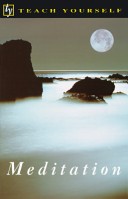 Meditation is a difficult subject for a ‘how to’ guide, because ultimately it doesn’t really matter how you do it.
Meditation is a difficult subject for a ‘how to’ guide, because ultimately it doesn’t really matter how you do it.
This is a pretty good attempt, though. James Hewitt gives the basic advice on posture, breathing, etc., and then takes us through various different methods, with a chapter on each: breathing meditation, visual meditation, listening, repeating a mantra, meditating on love, and meditating on the question, ‘Who am I?’
The best feature of the book is its breadth of outlook. Hewitt doesn’t really favour any particular school, or any particular religion or belief system. He quotes from Maharishi Mahesh Yogi on one page and Wordsworth on another. He covers Sufism, Whirling Dervishes, Christian mysticism, Hare Krishnas, Taoism, Zen, Jainism and many more, while also giving space to scientists who reject the spiritual basis of meditation but value it for its ability to increase relaxation and regulate blood pressure.
The breadth and fair-mindedness of the coverage, however, has a paradoxical effect. Rather than being inspired and intrigued by all the variations, I felt as if I’d been presented with a vast menu on which every choice was the same. As Hewitt keeps reminding us, no method is better than another. Basically, if you sit upright, minimise distractions and breathe smoothly and rhythmically, you’re meditating. It doesn’t matter too much whether you visualise a mandala, count your breaths, chant ‘Om’, listen to the ticking of a clock or imagine the sound of one hand clapping. Even the yogis and Zen masters who prescribe detailed meditation techniques admit that the details are unimportant. Hewitt tells a traditional Hindu story:
A man approached a great Yogi and asked by what method he could attain enlightenment. The guru said: ‘Chant RAMA [one of the Hindu names of God] a thousand times a day.’ Many years passed before the two men met again. The great Yogi immediately perceived that the other was enlightened. ‘Did you chant the sacred name, as I instructed?’ asked the teacher. ‘Yes, Master!’ came the reply. I became a solitary in the mountains, and every day for ten years I chanted MARA MARA MARA a thousand times, just as you told me to do.’ Mara, an anagram of Rama, is the name of the Devil!
If the details don’t matter, then why describe them in such detail? I suppose it’s to give you a choice and help you find the one that’s right for you, but to me it felt a bit repetitive, especially because many of the basic instructions were repeated in each chapter.
There were nevertheless some wonderful explanations, like ‘The Onion Game’, in which the layers of the self are stripped away:
I am not the body. I am not the senses. I am not this. I am not that. What then am I? What is the self? It is in the body. It is in the everybody until there is nothing left but the original oneness, the ‘something larger’ that many of us sense in quieter moments. It is everywhere. It is the All. It is Self. I am It. Absolute Oneness.
The range of this book made me wish certain topics could have been explored in more detail. It introduces a lot of ideas, but there’s no space in this format to do more than touch on them. I got the weird sense that the book could have been expanded to 1,000 pages or condensed to the back of a postcard. Still, I’d recommend it to those who are fairly new to meditation and want to learn more about the various techniques and to be introduced to a mind-expanding range of ideas from thinkers in different eras, faiths and regions of the world.




There are 12 comments
I like the analogy of an onion and meditation and the peeling away of layers to find the true self.
Hi Harvee,
Yes, the onion is a great way of looking at it, isn’t it? There’s lots of good stuff in this book. Thanks for stopping by!
This actually sounds intriguing to me as I am fascinated by variation and diversity even if many believe that the choice of techniques does not matter much.
I have never tried to meditate but I really should give it a go!
Yes, the variation in techniques is interesting. It gives you a lot of choice, so that if one doesn’t work for you, there’s always something else to try!
Does he ever say what works best for him? I would like to know that and why.
Because that’s how I see it, I don’t think there is one method that would work for everybody but everybody can find a method that will work.
And there are difference’s. If you have a problem with the chatter in your mind – the monkey mind – as some call it, a mantra can be very useful… And so on.
I loved your description of a mind filled with chatter, Caroline. Monkey mind – that is a very apt term.
Yes, I feel like that sometimes – leaping all over the place and chattering nonstop 🙂
Hi Caroline,
No, he doesn’t really go into personal experience very much – it’s more of a how-to book, so the tone is more impersonal. I think you’re right that different methods work for different people. It’s like learning – some people are visual learners, some prefer listening, etc. So maybe it wasn’t quite right to say it “doesn’t matter” how you do it – it may matter a great deal to an individual, even if in general there’s no “right” way to meditate.
Nice review, Andrew! This looks like an interesting introduction to readers who are new to meditation and who want to know more about it. I loved the passage on ‘The Onion Game’ that you have quoted. It made me think of a book on Zen Buddhism that I read a few years back.
Hi Vishy
Yes, it’s a good general introduction. The Onion Game is referred to quite a lot, I think, but the way it was explained here made a lot of sense to me. There are plenty of things like that in the book, that could be interesting if explored in greater depth, but this is a good place to start for the novice.
I like the approach this person suggests. I used to find meditation difficult until I just relaxed and stopped worrying about technique. Now I really enjoy meditating for one hour every morning. (I also found the binaural beats technique suggested on BestSpiritualReviews.com to be very helpful.)
Hi Peter
Thanks for visiting. One hour every morning sounds great. I meditate every morning, but can’t seem to keep going that long. I’ll try out that technique – thanks for the suggestion!